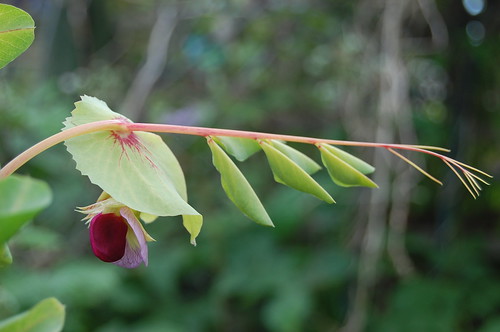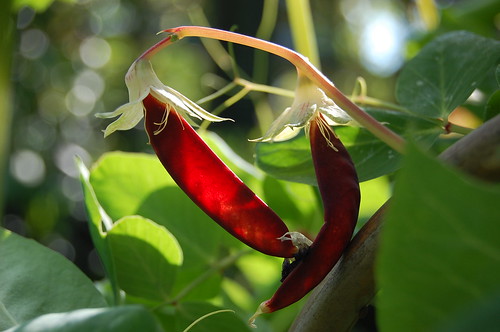
The unexpected discovery of the 'formula' for red-podded peas was the most exciting thing to happen in the garden in 2008. Without even meaning to, I'd created something unique and special and was very excited about what it might evolve into. Following all this excitement and expectation, its progress in 2009 was frustrating to say the least.
To recap briefly: I was working with two crosses, both involving a purple shelling pea with a golden yellow mangetout, with the aim of breeding a new purple mangetout variety for The Real Seed Catalogue. One of these crosses was Golden Sweet x Carruthers' Purple Podded, and among the F2 plants (the generation where all the genetic recombination happens) I found one single plant with deepest, richest blood red pods.

Beauty is not enough though, as spectacular as it is. Commercial seed catalogues are already rife with things which look good but don't taste particularly special. So much so, you could be forgiven for assuming there is a tradeoff between beauty and flavour (which there isn't) and that pretty vegetables will inevitably taste rubbish. I don't want that to happen with my red-podder. I want it to taste as good as it looks, otherwise there really is little point in it.
The original red-podded F2 plant was, unfortunately, a normal shelling pea with a fibrous membrane inside the pod. What I need is an edible podded version - which means a pod which doesn't produce a gristly inner membrane. The absence of fibre is actually achieved by the combination of two unrelated genes, both recessive. Golden Sweet, the 'mother' of red-podder, is a mangetout and has at least one of these genes, if not both. So even though red-podder itself had fibrous pods, there was a pretty good chance that it would be heterozygous at that locus - carrying a hidden recessive gene for edible pods. In fact, by the rule of Mendelian segregation it had a two in three chance of producing some edible pods, and only a one in three chance of being all gristly and inedible. Until I grew the next generation, I had no way of knowing whether it was heterozygous for that trait (carrying some variability) or homozygous (true breeding).

So in 2009 I grew the F3 plants. As the red-podded phenotype was only really asserted in one plant in my F2 crop, my F3 crop was based solely on the offspring from that one plant. The plants were absolutely stunningly gorgeous. Most of them had deep red pods, though some were coming out as plain yellows, and they all had wonderful rich colouring on the stems and tendrils, and attractive calyx markings. When the sun shines through the red pods they are out of this world.
Alas, growing the F3 revealed that red-podder is homozygous for gristly pods. In other words, it cannot produce edible pods. Homozygosity is a blessing for stabilising the traits you want. But when a trait you don't want is homozygous, you're stuffed. I could grow the offspring of my red pea for the next 100 years and probably never see an edible pod among them. The genes for edible pods are not there. It has only the genes which breed true for solid, yukky, gristly fibre.
There are five things I can do about this:
1. Stand in the middle of the garden and shout "BOLLOCKS!" in a really loud voice.
2. Go back to the F2 generation and grow out the rest of the seeds (I have about 20 left) in the hope of finding another red-podded phenotype but with edible pods.
3. Go back to an earlier generation still, the F1 seeds, and grow out some more of those. These plants will all look the same, all boring, with no red pods. But they will produce a fresh abundance of F2 seed, which I will be able to sow next year and that will give me a much better chance of an edible red-podded phenotype in the event that option 2 above doesn't yield anything.
4. I can switch to another line of F3 seed, even though none of them are proper red-podders. For example, I do have an F3 which is edible podded and produces yellow pods with a red blush. It's possible that if I grow out enough of its offspring I might get something with a stronger red. It should at least breed true for edible pods, which is half the battle. Even if it doesn't produce a decent red, it might make a nice variety in its own right - kind of peachy auburn!
5. I can grow my remaining seed from the red-podded F2 and cross it with something else. To retain the red pods I would need to cross it only with yellow podded peas - and mangetout ones at that. The most obvious thing would be a backcross to Golden Sweet, but I can go one better than that. My Luna Trick line, although not yet stabilised, is bred from Golden Sweet but is a huge improvement on it. A cross with that would give me an excellent chance of improving red podder's flavour as well as its pod structure. The other obvious cross to make is with option 4 above, which already has most of the right genes.

Apart from option 1, they will all take some time - at least a year and probably more - to get the results I want. But no matter, I have got all of them underway now. We'll see what 2010 brings.
13 comments:
They certainly are beautiful peas!
Some people might like a red-podded standard pea, non edible-podded. Are the peas themselves of this plant, good eating, apart from the pods?
Kevin
(another pea fancier in BC, Canada)
What a shame Rebsie. They do look stunning though ;-)
Excellent work Rebsie
The joys and frustrations of plant breeding summed up perfectly. I look forward to trying the finished product when It's available.
They certainly have the looks! My first thought was back-crossing, but I think your no. 1 suggestion at least gives immediate gratification!
Dear Rebsie, I get really excited about breeding peas when I read your blog, and I am looking forward to buying your new varieties when they come out. I would like some advice please. During the last few summers we have had trouble saving pea seeds because it rains all the time and the pods open and drop the peas or go all mouldy. However, the heritage variety called 'Irish Green Pea', which I got from the Irish Seed Savers Association is unbothered by persistent rain and produces unblemished peas. I would like to breed this into some of the other varieties and would like to know how best to start off. Do you know how many genes might be involved in pod resiliance?
just found your blog through ag biodiversity and love it! especially all the serious amateur plant breeding
Hello Kevin, yes that's a fair point and I am open to the idea of developing a standard shelling pea with red pods. I've done minimal taste-testing because I need to keep most of it for seed, but so far the peas themselves are mealy and bitter and not really worth eating fresh. They might be edible as a soup pea. I know I can do better than this - it's just going to take a couple of years longer.
Madeline - that's a good question. I don't know anything about the genes for weather resistance - will have to look in the JIC's Pisum gene database and see if they have anything. You can learn so much from experimentation though, so I would suggest making crosses with Irish Green Pea to any/all of the other peas which you want to improve. It should be obvious even in the F1 generation whether the rain resistance trait (if it is just one gene) is dominant or recessive. Then in the F2 you will get a much clearer picture and be able to select the lines that work best. I'll see what I can find out in the mean time.
Thanks everyone for comments - they are always appreciated.
Thanks, I will try.
@Madeline McKeever
It might be worth contacting the Open Plant Breeding Foundation, whose avowed aim is "empowering organic growers to breed for disease resistance" - their advisor, Raoul Robinson has done work on breeding disease resistant potatoes and beans using recurrent mass selection techniques. He has a couple of ebooks available on the subject: http://sharebooks.ca/ebooks_by_author2.php?author=Robinson%2C+Raoul+A.
I would guess that the kind of weather resistance you describe would be polygenic and therefore amenable to mass selection techniques.
Rebsie,
One of the plants from the seed you sent me last season had potential as a shelling pea, I actually sent you an email about it a few days ago.
I managed to save a few seed from it and their yours if you want them.
Good to see your peas are still thriving. Those red pods are beautiful.
I'm getting quite a collection of different peas varieties now - and will have to be more selective or I'll run out of space.
I still love the Salmon Flowered peas and will grow them in the decorative borders this year - thank you for the seed swap the other year.
Best wishes
Celia
Really fascinating stuff! Fingers crossed for this year's growing. I can see real commercial potential for a red mangetout!
These r gorgeous!
I would grow them in the flowr beds...
Stuff edibility, they're too purdy to eat neway.
Interesting that they're inedible... Usually brighter colours come with increased taste.
Post a Comment